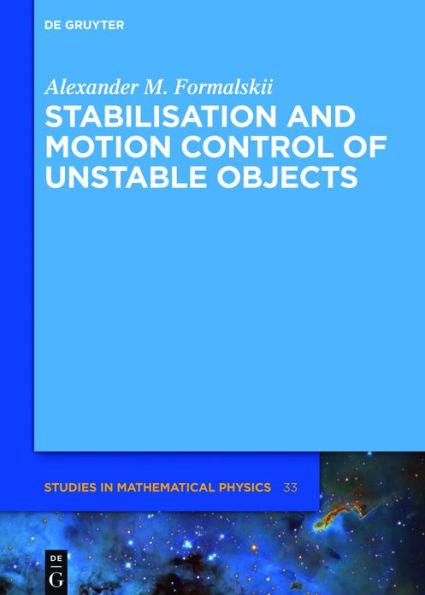5
1

Stabilisation and Motion Control of Unstable Objects
255
by Alexander M. Formalskii
Alexander M. Formalskii

Stabilisation and Motion Control of Unstable Objects
255
by Alexander M. Formalskii
Alexander M. Formalskii
Hardcover
$230.00
-
PICK UP IN STORECheck Availability at Nearby Stores
Available within 2 business hours
Related collections and offers
230.0
In Stock
Overview
Systems with mechanical degrees of freedom containing unstable objects are analysed in this monograph and algorithms for their control are developed, discussed, and numerically tested. This is achieved by identifying unstable modes of motion and using all available resources to suppress them. By using this approach the region of states from which a stable regime can be reached is maximised.
The systems discussed in this book are models for pendula and vehicles and find applications in mechatronics, robotics as well as in mechanical and automotive engineering.

Product Details
| ISBN-13: | 9783110375824 |
|---|---|
| Publisher: | De Gruyter |
| Publication date: | 11/03/2015 |
| Series: | De Gruyter Studies in Mathematical Physics , #33 |
| Pages: | 255 |
| Product dimensions: | 6.69(w) x 9.45(h) x 0.03(d) |
| Age Range: | 18 Years |
About the Author
Alexander Formalskii, Lomonosov State University, Moscow, Russia.
Table of Contents
PrefaceChapter 1. Devices Containing One-Link Pendulum§ 1. Physical pendulum with fixed suspension point1. Motion equations2. Controllability domain3. Maximization of attraction domain4. Delay in feedback loop5. Nonlinear control6. Controllability domain for nonlinear model§ 2. Pendulum with suspension point located at the center of a wheel1. Motion equations2. Controllability domain3. Maximization of attraction domain4. Nonlinear control§ 3. Pendulum with flywheel1. Design of the pendulum with flywheel2. Motion equations3. Local stabilization of the pendulum in the upper unstable equilibrium4. Damping of the flywheel angular speed5. Rocking and damping of the pendulum6. Transferring the pendulum from the lower equilibrium to the upper one7. Numerical study8. Experiments§ 4. Wheel rolling control using a pendulum1. Mathematical model of the device2. Steady motions3. Stability of steady motions§ 5. Optimal rocking and damping of the swing1. On design of optimal feedback control for second-order systems2. Mathematical model of the swing3. Maximization of the swing amplitude4. Minimization of the swing amplitude5. Control of the swing with consideration of aerodynamic resistance and dry friction§ 6. Pendulum control with minimal energy cost1. Energy cost estimation2. Transferring the pendulum to the unstable equilibrium3. Transferring the pendulum to the stable equilibriumChapter 2. Two-link Physical Pendulum§ 7. Local stabilization of inverted pendulum with one control torque1. Mathematical model of the pendulum2. Linearized model3. Controllability domains4. Feedback control design, maximization of the attraction domain5. Numerical study§ 8. Optimal control design of two-link pendulum rocking and damping1. Mathematical model2. Reduced angle3. Optimal control for rocking the pendulum4. Optimal control for damping the pendulum5. On transferring the pendulum from the lower equilibrium to the upper one§ 9. Global stabilization of inverted pendulum with control applied at the hinge between links1. Mathematical model2. Cascade form of dynamics equations3. Control for rocking the pendulum4. Tracking of desired inter-link angle variation5. Local stabilization of the inverted pendulum6. Numerical study§ 10. Global stabilization of the inverted pendulum with control applied at the suspension point1. Mathematical model2. Pendulum rocking3. Straightening of the pendulum4. Linear model, local stabilization5. Numerical study§ 11. Multilink pendulum on a movable base1. Multilink pendulum on a wheel2. One-link pendulum on a wheel3. Global stabilization of inverted pendulum4. Controllability domain5. Design of time-optimal trajectories6. Pendulum on a cart7. Decrease of frequencies under imposed constraintChapter 3. Ball on a Beam§ 12. Stabilization of a ball on a rectilinear beam1. Mathematical model of the system2. Linearized model3. Feedback control synthesis4. Numerical study§ 13. Stabilization of a ball on a circular beam1. Mathematical model2. Linearized model3. Feedback control4. Numerical studyChapter 4. Gyroscopic Stabilization of Robot-Bicycle§ 14. Designs of two bicycle types1. Bicycle with one steering wheel2. Bicycle with two steering wheels3. Gyroscopic stabilizer4. Equations of bicycle roll oscillations§ 15. Control law for stabilizing bicycle in the upright position1. Measurement of bicycle roll angle with accelerometers2. Bicycle motion along a straight line3. Bicycle motion along a circular line4. Numerical and experimental studyReferencesFrom the B&N Reads Blog
Page 1 of
